skip to main |
skip to sidebar
Tuesday, 8th May 2018
Last night, the Doctor and I returned to his Yangon home for the first time since leaving on Friday 27th April. In that time, the Doctor has carried out two full weekends of consultations at Bagan Medical Clinic and, in between those weekends, we made a fascinating side trip to Chin State led by the Monk from the Clinic and accompanied by the Doctor's wife. After the second weekend at the Clinic, we made food donations at two Orphanages in Pyin Oo Lwin and made a journey by train over the famous Gokteik Viaduct before flying back to Yangon from Mandalay.
I slept very well on Monday night and was told that Tuesday was to be a rest day for me. After breakfast, I settled down in my room to work on the internet, dealing with e-mails and updating this blog.
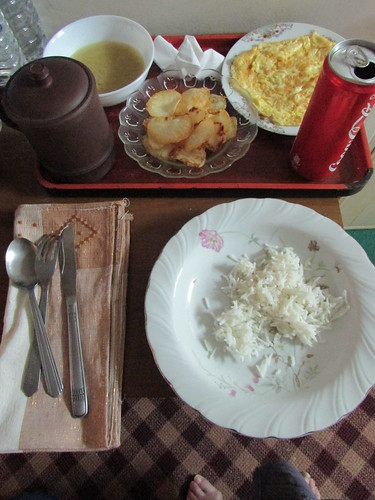
A splendid meal, tailored to my rather conservative tastes, at the Doctor's house in Yangon.
I've enjoyed many great experiences visiting different parts of the world (for more details, see the post Jan Ford's Travels) but I think that this trip has surpassed any previous travelling I've done. The emotion of being immersed in all this activity is almost overwhelming. I've met some lovely, welcoming people.
Tomorrow, the Doctor and I go on a railway visit (surprise, surprise) then on Thursday I've a meeting with Eddie Teh, Belmond's General Manager in Myanmar.
Then, my extraordinary trip to Myanmar will be over and early Friday morning I'm booked to fly out of Yangon's Mingalardon airport.
Related posts on this website
This is one of a series of posts describing my 13th visit to Myanmar. The post Travelling again is the first post in the series.
Clicking on the 'Next report' link displays the post describing the next events. In this way, you may read about the trip in sequence.
Next report
Alternately, clicking on the 'All my Burma-2018 reports' link displays all the posts on this trip in reverse date-of-posting order.
All my Burma-2018 reports
My pictures
Where necessary, clicking on the image above will display an 'uncropped' view or, alternately, pictures may be selected, viewed or downloaded, in various sizes, from the albums below:-
Yangon around and about.
All my pictures on this trip to Myanmar can be found at Burma 2018.
['My pictures' links and picture added 6-Aug-2018]
This post adds some technical comments to the post Gokteik Viaduct
We arrived at Pyin Oo Lwin station a little before 08:00 and went to the booking office for our pre-arranged tickets from Pyin Oo Lwin to Nawngpeng. Handwritten tickets for Upper Class with seat reservations were prepared with due ceremony and my passport number was included in the ticket information.
In the booking hall there was a black notice board with details of the two departures and with that day's notes added in chalk in English. Our train number 131 was shown as an Up train. In the past, it took me a while to realise that UP and DOWN on the Mandalay-Yangon line refer to trains to and from Mandalay, respectively. Thus, I'd expected the train we were about to board to be a Down train but, apparently, it's not so.
To help passengers find their correct coach, at principal stations there is an Arrivals and Departures board showing the make-up of passenger trains. Each coach is represented by a disc with vehicle details inscribed. The appropriate discs are hung on a horizontal series of small hooks so that the composition of each train is readily visible.
The discs representing our train number 131, left to right, were marked Guard, Parcels, Upper 2, Ordinary 3, Ordinary 2, Upper 1, Ordinary 1, Locomotive.
Train number 132 was similarly represented.
Our train number 131 was already in the platform with Bo-Bo-Bo DF.2080 in red and blue livery (built in China by Dalian Locomotive and Rolling Stock) on the front of 3 air braked carriages (2 Ordinary Class and 1 Upper Class) with a bogie parcels van (type GBHV) and a bogie Guard's/Parcels van (type VBHV) on the rear. The locomotive and all vehicles were air braked and fitted with automatic couplers. The Doctor said his friend had told him that the load limit from Mandalay to Pyin Oo Lwin is 180 tons but that, beyond Pyin Oo Lwin, the limit is increased to 240 tons.
Another Bo-Bo-Bo, DF.1629 in brown and cream livery, was propelling two flat cars used as shunters' wagons towards the rear of our train, number 131.The flat cars were modern, air braked with a wheel to operate a handbrake. Both cars had locating dowels at each corner for carrying a standard shipping container. The one flat car, R.9.2021 had two additional dowels perhaps for carrying half-length containers and the maker's plate 'TITAGARH WAGONS LIMITED 2013'. The Titagarh Group (website here) is a heavy engineering company based in India but now developing an export market.
It was clear that DF.1629 was going to remove the two goods wagons from the rear of train number 131, with a view to strengthening the passenger accommodation. But it took three attempts before the coupling between the leading shunters' wagon and the rear coach mated correctly.
Whilst the additional coaches were being fetched, we'd visited the Stationmaster's Office so that I could photograph the track diagram. The 'wye' at the bottom of the diagram serves the loco shed which I understand is still in use.
Approaching a Block Station like Pyin Oo Win in either direction, the first indication a driver receives is a white, rectangular warning board, set half a mile before the distant signal. All distant signals are fixed and come in a wide variety of designs. Next comes the 'Outer' or 'Home' stop signal. This is operated by the pointsman at the entrance to the station where a green flag indicates that the points have been set and clipped for the train to enter the station. Before leaving the station, the driver must be in possession of a paper Line Clear form for the Block Section ahead and must have a green flag from the pointsman to indicates that the points have been set and clipped for the train to leave the station. Finally, the train passes a 'Limit of Shunt' board. This is a white square with a smaller red square in the middle.
The station is not interlocked in the sense of having a lever frame but four Trapped Key Locking Boxes were mounted on the wall near the door. The Locking Boxes for roads 3, 4 and 5 had their keys but the unmarked box had no key, presumably because of the shunt in progress. I took pictures of the Stationmaster on the radio, the book of paper Line Clear forms authorising train movements and the Train Register book.
For more information on the control of trains in Myanmar, see the post here and for information about the control of points and interlocking see the post here. Alternately, there's an index of all my Myanma Railways posts (which may not always be up-to-date) here.
Back on the platform I watched DF.1629 propelling two Upper Class carriages and the two goods wagons onto the train and, to my surprise, the re-inforced train departed at 08:22 as scheduled.
The ruling gradient appeared to be downhill and we we travelling faster that I previously recalled. We came to a brief stand at the approach to a station and, once the points were set away from a sand drag, the upper quadrant signal cleared and we entered the platform. We carried on, making brief intermediate stops, to Hsam Ma Hse. This had the normal passing loop plus a third line on which DF.2063 (red and blue livery) waited with a ballast train, adjacent to a yard with numerous large piles of ballast. There was a belt-type elevator which apparently was used to load the ballast wagons.
Our next stop was at Nawnghkio, a more important station, where we stood for a few minutes loading and unloading freight.
Five or six kilometres beyond Nawnghkio, we started getting views of the famous viaduct. What struck me was how much higher than the bridge we were and I wondered how we'd lose height. Well, we did it by twisting and turning down the mountain side, around tight curves and descending through rock cuttings. Finally, we headed away at right angles with the bridge on our right. Below us, there was a parallel line at lower level with the semaphore Outer signal for Gokteik. We traversed the expected 'dumbell' loop now heading back towards the bridge now on our left and stopped at the small isolated station of Gokteik. The line curved left to lead us onto the viaduct which we traversed slowly (there's a 5 m.p.h. limit displayed). This monumental structure, set in impenetrable jungle, gives feelings of awe that are hard to convey.
at the entry to the station where hand operated
Immediately after the viaduct, there are two tunnels. The second was certainly brick-lined, I'm not sure about the first. The locomotive was now working hard as we climbed away from the bridge, so I was not surprised when we passed a sand drag (trailing to us) protected by stop signals. Soon, we arrived in Nawngpeng, where we disembarked. I made it a 'right time' arrival. However, the train did not, as suggested by the travel website ‘The Man in Seat 61’ here wait for train 132 to arrive and leave at 12:25 but set off for Lashio a few minutes after noon.
Station distances from Wikipedia
Pyin U Lwin 422 1/2
Pwe Kaul 427 3/4
Wet Wun 433 1/2
Sin Lan Su 438 1/4
Hsam Ma Hse 444
Nawnghkio 456
Gokteik 463 Gokteik Viaduct
Nawngpeng 472 1/4
The complete list is here.
Information from 'The Man in Seat 61'
There is one passenger train daily each way over the Gokteik Viaduct. Upper and Ordinary Class seats are provided.
Mandalay to Pyin Oo Lwin is 67 km (42 miles).
Mandalay to Hsipaw is 206km (129 miles).
Mandalay to Lashio is 280 km (175 miles).
Train number 131: Mandalay > Pyin Oo Lwin > Lashio
| Station |
Arrive |
Depart |
| Mandalay |
|
04:00 |
| Pyin Oo Lwin (Maymyo) |
07:52 |
08:22 |
| Gokteik |
11:03 |
11:08 |
| Nawngpeng |
11:58 |
12:25 |
| Kyaukme |
13:19 |
13:39 |
| Hsipaw (Thibaw) |
14:55 |
15:15 |
| Lashio |
19:35 |
|
Train number 132: Lashio > Pyin Oo Lwin > Mandalay
| Station |
Arrive |
Depart |
| Lashio |
|
05:00 |
| Hsipaw (Thibaw) |
09:25 |
09:40 |
| Kyaukme |
11:05 |
11:25 |
| Nawngpeng |
12:22 |
12:30 |
| Gokteik |
13:23 |
13:25 |
| Pyin Oo Lwin (Maymyo) |
16:05 |
17:40 |
| Mandalay |
22:40 |
|
For all the information on train travel in Burma on this website, click here.
My pictures
Where necessary, clicking on an image above will display an 'uncropped' view or, alternately, pictures from may be selected, viewed or downloaded, in various sizes, from the albums below:-
By train over Gokteik Viaduct 7th May 2018.
All my pictures on this trip to Myanmar can be found at Burma 2018.
['My pictures' link added 4-Aug-2018]
Did I mention my interest in railways? All my posts on the railways of Myanmar can be found here. When I first told the Doctor that I wanted to travel on the train over the famous Goktiek Viaduct, he insisted on making arrangements for me. As things worked out, he was also able to accompany me on the train.
Monday, 7th May 2018
I took breakfast in the Dining Hall on the 5th floor of Hotel Maymyo then checked out ready to be picked up by the Doctor at 7.40 a.m. to catch the train from Pyin Oo Lwin station across the Gokteik Viaduct.
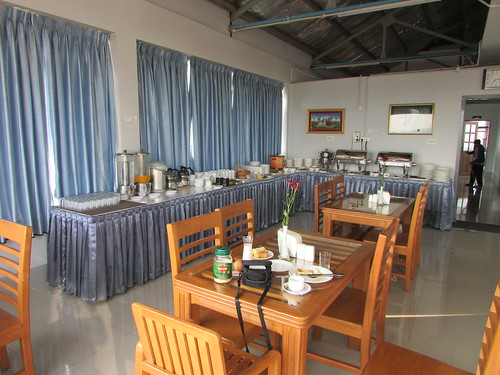
Breakfast at Hotel Maymyo, Pyin Oo Lwin, 7th May 2018
The Gokteik Viaduct, opened 1900, is a steel trestle bridge on the railway line from Mandalay to Lashio almost 700 metres long which carries a single track at a height of over 300 metres above the ground. There's a Wikipedia article here.
The height and length of the viaduct make it a ‘must see’ for many tourists and the travel website ‘The Man in Seat 61’ has more information here.
Train 131 from Mandalay to Lashio was scheduled to leave Pyin Oo Lwin at 08:22, pass over the Gokteik Viaduct and arrive at Nawngpeng at 11:58. It was arranged that our car would go ahead by road to Nawngpeng using the Oriental Highway, pick up the Doctor and the writer on arrival by train then drive us via Pyin Oo Lwin to Mandalay Airport. The Doctor had booked tickets for us to Yangon on separate flights to keep the cost down.
Well, all the arrangements worked well and the viaduct is certainly impressive. There were a number of European travellers on the train who also seemed to enjoy the experience and many photographs were taken. You’ll probably be relieved to learn that I’m deferring the technical railway stuff to a later post (but you can find it at Gokteik Viaduct Notes then use the 'back button' to return here).
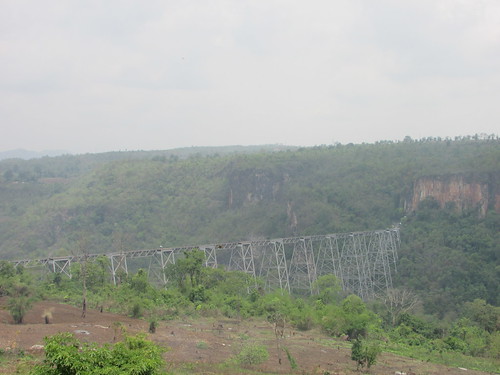
By train over Gokteik Viaduct 7th May 2018
The car collected us at Nawngpeng as planned and we set off on the Oriental Highway towards Pyin Oo Lwin. The amount of lorry traffic was astonishing, mainly 8-wheel fixed wheelbase and 10- and 12-wheel articulated rigs. Via a series of spectacular zig-zags, the road descended into the valley then, using a similar technique, climbed up the opposite side of the valley.
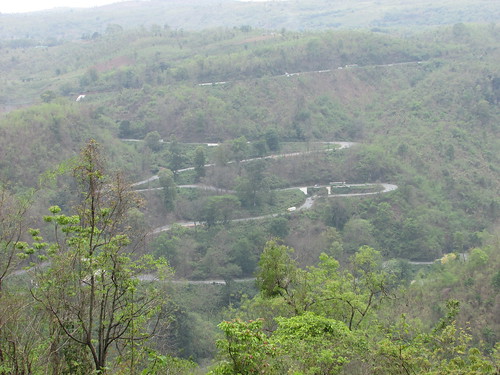
Nawngpeng - Mandalay Airport by road 7th May 2018: View of zig-zag road from opposite side of valley.
As I’ve previously reported, Myanmar drives on the right (despite the fact that many vehicles, like the Toyota Crown I was travelling in, have the driver on the right). However, the bigger lorries need space to turn so, even if they should be driving on the inside of a hairpin bend, they simply take the wrong side of the road so as to be on the outside of the hairpin. Drivers of smaller vehicles travelling in the opposite direction, with admirable pragmatism, simply also adopt the wrong side of the road until they’re clear of the offending lorries and so the traffic keeps moving (though it looks frightening).
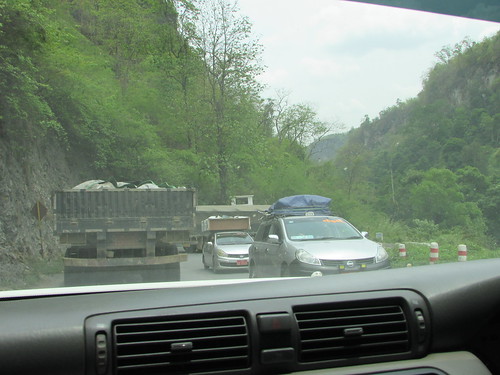
Nawngpeng - Mandalay Airport by road 7th May 2018: On the hairpins, traffic informally adopts the wrong side of the road to allow lorries space to turn.
Having reached a plateau, our route continued on easier gradients. We stopped at a large, obviously popular, tea-shop. The floor was littered with empty water bottles and debris from a busy morning but I was amazed when the place setting for each diner (plate, bowl, tea cup and cutlery) arrived packed in a plastic bag and looked clean. Fearing my foreigner’s delicate digestion, the Doctor often washes cups or cutlery again before letting me use them but on this occasion there was no need.
We carried on to Pyin Oo Lwin where the Doctor and I enjoyed a cup of heated milk (a sort of informal Pasteurisation) at a roadside shop.

The roadside shop in Pyin Oo Lwin where we drank heated milk.
As we left Pyin Oo Lwin, the Doctor made some purchases at a group of roadside stalls (Pyin Oo Lwin is famous for strawberries).
Although parts of the road descending to the plain were already dual-carriageway the last time I was on it, massive road improvement has occurred since. This construction project is ongoing - as we came nearer to Mandalay, the Oriental Highway became one vast construction site with traffic in both directions rushing across a dusty, unsealed surface with no markings or verges and poor visibility from the clouds of dust. The speeding vehicles were sharing the space with dozens of excavators, graders, road rollers and tipper lorries all oblivious to the traffic and operating within inches of the passing cars, pick-ups lorries and tankers. It was an amazing, anarchic scene. There were also a number of rather alien-looking tracked vehicles, each attached by an umbilical cord to a large, wheeled packaged unit. I assumed that they were pneumatic rock drills.

Road improvements in progress on the Oriental Highway.
At last, we returned to the relative discipline of a dual carriageway, paid at a couple of toll stations, passed through Myitnge and took the road to Mandalay Airport.
The Doctor had little time to catch his flight to Yangon and dashed off to check-in, encumbered with various shopping carriers of his purchases. I said farewell to our driver and the young lady from Belmond as they set off on the long drive back to Bagan. I then had a couple of hours before my own flight to Yangon. A little after 9.00 p.m., I arrived at Mingalardon Airport to find the Doctor and his wife waiting for me. We returned to the Doctor's house by taxi and, tired but thrilled by our various explorations, I slept well with the promise that the following day was a day of rest for me. For once, I was disinclined to argue.
Related posts on this website
This is one of a series of posts describing my 13th visit to Myanmar.
The post Travelling again is the first post in the series.
Clicking on the 'Next report' link will show the post describing the next events. In this way, you may read about the trip in sequence.
Next report
Alternately, clicking on the 'All my Burma-2018 reports' link displays all the posts on this trip in reverse date-of-posting order.
All my Burma-2018 reports
My pictures
Where necessary, clicking on an image above will display an 'uncropped' view or, alternately, pictures from may be selected, viewed or downloaded, in various sizes, from the albums below:-
Hotel Maymyo, Pyin Oo Lwin, 7th May 2018.
By train over Gokteik Viaduct 7th May 2018.
Nawngpeng - Mandalay Airport by road 7th May 2018.
All my pictures on this trip to Myanmar can be found at Burma 2018.
['My pictures' links added 4-Aug-2018: Pictures embedded 23-Aug-2018]
Sunday, 6th May 2018
Support for orphanages in Myanmar is described in a number of posts, covering schools and orphanages, labelled 'Education'. You can display them all by clicking here.
Doe Pin orphanage is situated on the Mandalay - Pyin Oo Lwin road, just before you reach Pyin Oo Lwin. I think my last visit was in 2011 (described here).
Our visit to Doe Pin in 2018 was to make the formal presentation of a gift from a Swiss charity, Enfants d'Ailleurs Foundation, arranged by Doctor Hla Tun through Belmond 'Road to Mandalay'. This donation, valued at 2,000,000 Kyat, comprised Rice, Cooking Oil, Gram Pea (a type of chickpea), Onions and Potatoes. When we entered the assembly hall, the purchased food was laid out impressively.
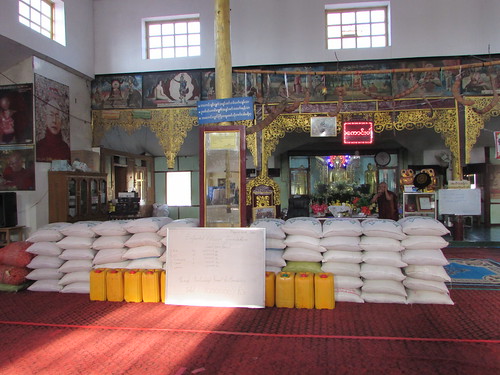
Doe Pin 6th May 2018: The donation of Rice, Cooking Oil, Gram Pea (a type of chickpea), Onions and Potatoes.
The Abbot was informed of our arrival and he appeared, as ebullient and friendly as I remembered him from previous visits. Although there are around 600 boy orphans here, a much smaller number were present for our visit with the balance due to return before the start of the new academic year. Children from 18 different ethnic groups are included in the total. The Abbot summoned the children present, the formal donation was made and lots of photographs were taken to record the event. The younger children sang for us.

Doe Pin 6th May 2018: Dr. Hla Tun, the Abbott and a small group of orphans.
We then drove through the town to reach the Shewe Sin Minn Orphanage for Girls. I think my first visit was in 2011 (described here) but I have made visits since. As at Doe Pin, our aim was to make the formal presentation of a gift from a Swiss charity, Enfants d'Ailleurs Foundation, arranged by Doctor Hla Tun through Belmond 'Road to Mandalay'. This donation, also valued at 2,000,000 Kyat, comprised Rice, Cooking Oil, and artificial meat balls. The open area in front of the buildings was crowded by hundreds of young nuns and orphans.

Shwe Sin Minn Orphanage, 6th May 2018
All told, there are about 600 girls here from four different ethnic groups although not all were present for our visit. I was astounded at the changes in the buildings which had been embellished with typical religious features and re-painted. More new construction was in progress. The orphanage was founded and run by two sisters. The younger one, who is headmistress welcomed us and accepted the donation. The elder sister, who is head nun, appeared briefly. Once again, the purchased food was on display and the formal donation took place with the usual recording of the scene photographically. All the girls then sang for us.
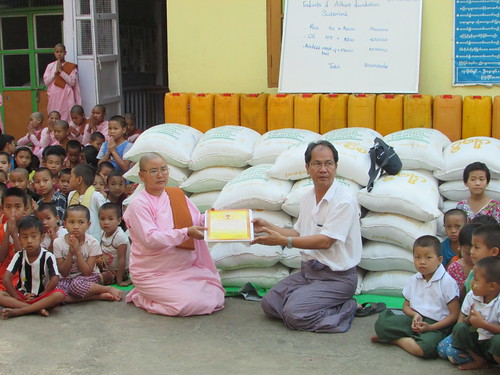
Shwe Sin Minn 6th May 2018: The formal donation of food.
We made a brief visit to Pyin Oo Lwin Hospital, visiting two young Hare Lip patients whose surgery had been paid for by 'Road to Mandalay' guests.

Dr. Hla Tun with Hare Lip patients at Pyin Oo Lwin Hospital 6th May 2018
The Doctor had arranged a visit to the nearby Yadanar Mun Aung monastery. This is a large teaching monastery housed in a number of buildings within the monastery compound. We were given an audience with the abbott, who invited me to overnight in the guesthouse forming part of the monastery but the Doctor declined on my behalf as he had already made arrangements for me to stay in a hotel.
After we left the monastery, I was taken to the Hotel Maymyo. This was a modern, comfortable hotel aiming to encourage tourists. The only problem was that my room was on the 3rd floor (that's 'American' 3rd which the British usually call 'second floor'), the 'Dining Hall' for breakfast was on the 5th floor and there was no lift. I'm a bit slow on stairs these days but it was a minor inconvenience.
Although the hotel served breakfast, it did not provide other meals so I went by car with the others to a tea-shop for dinner. Then they dropped me back at the hotel (they were not staying at the hotel) and I was delighted to find that the hotel had a very usable Wi-Fi.
Related posts on this website
This is one of a series of posts describing my 13th visit to Myanmar.
The post Travelling again is the first post in the series.
Clicking on the 'Next report' link will show the post describing the next events. In this way, you may read about the trip in sequence.
Next report
Alternately, clicking on the 'All my Burma-2018 reports' link displays all the posts on this trip in reverse date-of-posting order.
All my Burma-2018 reports
My pictures
Where necessary, clicking on an image above will display an 'uncropped' view or, alternately, pictures from may be selected, viewed or downloaded, in various sizes, from the albums below:-
Doe Pin 6th May 2018.
Shwe Sin Minn 6th May 2018.
Hare lip patients at Pyin Oo Lwin Hospital.
Hotel Maymyo, Pyin Oo Lwin, 7th May 2018.
All my pictures on this trip to Myanmar can be found at Burma 2018.
['My pictures' links added 4-Aug-2018]












